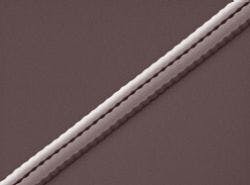UC San Diego engineers develop CMOS pulse compressor on silicon
San Diego, CA--Researchers at the University of California, San Diego (UC San Diego) have developed the first ultracompact, low-power optical pulse compressor on a silicon chip to be described in the scientific literature.1 The short-pulse generator eliminates a roadblock on the way to optical interconnects for use in PCs, data centers, imaging applications, and so on.
"Our pulse compressor is implemented on a chip, so we can easily integrate it with computer processors," said Dawn Tan, who led development of the pulse compressor.
"Next-generation computer networks and computer architectures will likely replace copper interconnects with their optical counterparts, and these have to be complementary metal oxide semiconductor (CMOS) compatible. This is why we created our pulse compressor on silicon," said Tan.
The pulse compressor will also provide a cost-effective method to create short pulses for a variety of photonic technologies such as time-resolved spectroscopy and optical-coherence tomography.
Good enough for OTDM
The compressed pulses are seven times shorter than the original--the largest compression demonstrated to date on a chip. Until now, pulse compression featuring such high compression factors was only possible using bulk optics or fiber-based systems, both of which are bulky and not practical for optical interconnects for computers and other electronics.
The combination of high compression and miniaturization are possible due to a nanoscale integrated dispersive element developed and designed primarily by Tan.
The pulse compressor works in two steps. In step one, the spectrum of incoming laser light is broadened. In step two, the dispersive element ensures that all wavelengths in the pulse travel at the same speed. This speed synchronization is where pulse compression occurs.
"We've created a compression component that is essential for optical time-division multiplexing (OTDM)," said Tan. The researchers say they are the first to report a pulse compressor on a CMOS-compatible integrated platform that is strong enough for OTDM.
"In the future, this work will enable integrating multiple 'slow' bandwidth channels with pulse compression into a single ultra-high-bandwidth OTDM channel on a chip. Such aggregation devices will be critical for future inter- and intra-high speed digital electronic processors interconnections for numerous applications such as data centers, field-programmable gate arrays, high performance computing and more," said Yeshaiahu Fainman, another UC San Diego researcher.
For more info, see http://www.ucsd.edu/.
REFERENCE:
1.Dawn T.H. Tan et al., Nature Communications 1, (1 November 2010) | doi:10.1038/ncomms1113.
Subscribe now to Laser Focus World magazine; it's free!

John Wallace | Senior Technical Editor (1998-2022)
John Wallace was with Laser Focus World for nearly 25 years, retiring in late June 2022. He obtained a bachelor's degree in mechanical engineering and physics at Rutgers University and a master's in optical engineering at the University of Rochester. Before becoming an editor, John worked as an engineer at RCA, Exxon, Eastman Kodak, and GCA Corporation.
